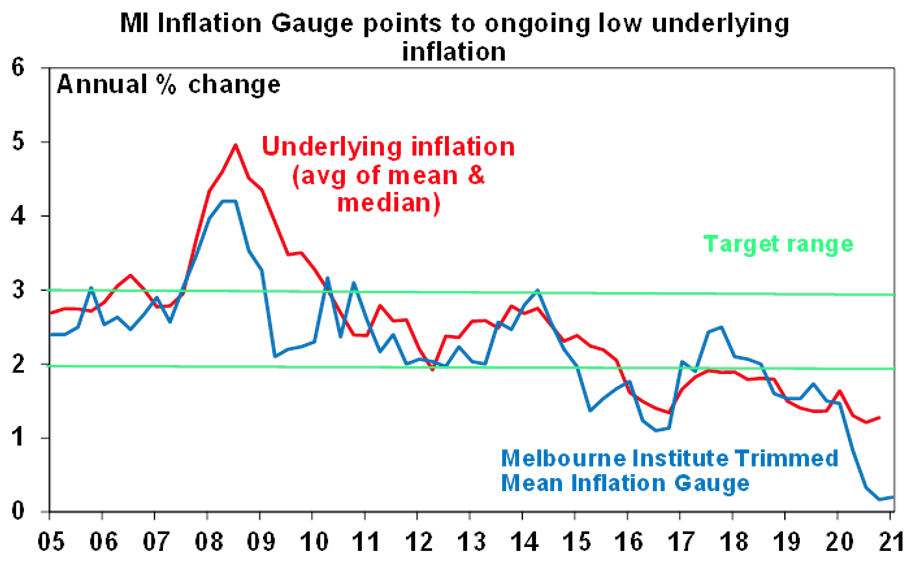

The run of strong Australian economic data releases largely continued last week, with strong business conditions PMIs, record levels for housing finance driven by owner occupiers and first home buyers and finance for new construction, another surge in building approvals driven by approvals for houses, continuing solid gains in house prices albeit with Sydney and Melbourne lagging, a further rise in ANZ job ads and a continuing strong recovery in payroll jobs after adjusting for seasonality. ABS final retail sales data confirmed a -4.1% decline in December retail sales as strong Black Friday sales brought spending forward and the covid scare in late December impacted. But this followed several exceptionally strong months, they are up a whopping 9.6% year on year and they rose a stronger than expected 2.5% in real terms in the December quarter. And the trade surplus rebounded in December, albeit by less than expected.
Meanwhile, the Melbourne Institute’s January Inflation Gauge continues to point to very low underlying inflation pressures.

While the rebound in house prices – on the back of record low rates, government incentives, “escape from the city”, FOMO and reopening - is a concern from an affordability perspective at least it’s being accompanied by a surge in housing construction which combined with a hit to underlying housing demand from the slump in immigration of around 100,000 dwelling per annum could ultimately lead to improved affordability – particularly in inner city Sydney and Melbourne.
Finally, APRA data indicates that the proportion of loans on payment holidays fell to just 1.9% of the total by value in December which is down from 10% in May, and the proportion of mortgages on payment holidays fell to just 2.4% which is down from 11% in May. So a huge surge in distressed property sales once payment holidays end is not going to happen!
What to watch for the rest of this week
The December half earnings reporting season will hot up with 23 major companies reporting including: CBA, CSL and IAG (today); AGL, AMP, ASX, Newcrest, Transurban and Telstra (tomorrow); and Mirvac and Computershare (Friday). Earnings are now expected to rebound in 2020-21 by 25% after the pandemic driven -24% plunge last financial year. In terms of sectors, earnings for resources are expected to rise by 47%, banks by 31% and IT stocks by 109%. Healthcare, media and gaming stocks are likely to see around 17% earnings growth and retailers are likely to surprise on the upside. Key themes are likely to be a rebound in dividends, stocks benefiting from a surge in housing activity and a likely outperformance of value and cyclicals over growth stocks, and small caps outperforming large caps.
Outlook for investment markets
Shares remain at risk of a short-term correction after having run up so hard recently and 2021 is likely to see a few rough patches along the way. But timing such moves will be hard and looking through the inevitable short-term noise, the combination of improving global growth helped by more stimulus, vaccines and low interest rates augurs well for growth assets generally in 2021.
We are likely to see a continuing shift in performance away from investments that benefitted from the pandemic and lockdowns - like US shares, technology and health care stocks and bonds - to investments that will benefit from recovery - like resources, industrials, tourism stocks and financials.
Australian shares are likely to be relative outperformers helped by: better virus control enabling a stronger recovery in the near term; stronger stimulus; sectors like resources, industrials and financials benefitting from the rebound in growth; and as investors continue to drive a search for yield benefitting the share market as dividends are increased resulting in a 4.5% grossed up dividend yield. Expect the ASX 200 to end 2021 at a record high of around 7200.
Ultra-low yields and a capital loss from a 0.5-0.75% or so rise in yields are likely to result in negative returns from bonds.
Unlisted commercial property and infrastructure are ultimately likely to benefit from a resumption of the search for yield but the hit to space demand and hence rents from the virus will continue to weigh on near term returns.
Australian home prices are likely to rise another 5% or so this year being boosted by record low mortgage rates, government home buyer incentives, income support measures and bank payment holidays but the stop to immigration and weak rental markets will likely weigh on inner city areas and units in Melbourne and Sydney. Outer suburbs, houses, smaller cities and regional areas will see relatively stronger gains in 2021.
Cash and bank deposits are likely to provide very poor returns, given the ultra-low cash rate of just 0.1%. Although the $A is vulnerable to bouts of uncertainty about coronavirus and China tensions and RBA bond buying will keep it lower than otherwise, a rising trend is still likely to around $US0.80 over the next 12 months helped by rising commodity prices and a cyclical decline in the US dollar.